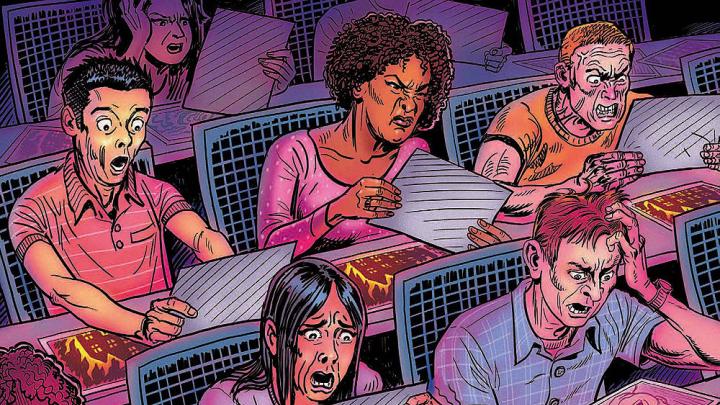When people describe feeling “angry” or “distressed” or “dejected,” what do they really mean? Psychologists vigorously debate whether the words individuals use to describe their emotions actually reflect fixed states in the brain, or are merely convenient fictions for talking about feelings. “Are anger, sadness, and disgust” really distinct, universal emotions, asks Erik Nook, a fourth-year doctoral student in clinical psychology, “or is it the case that, because we have learned different concepts for different emotions, we produce those emotions?” Nook particularly wants to understand why some people seem to have more precise, granular emotional concepts—they distinguish among feeling disappointed, frustrated, or discouraged, for example—while others describe a general, undifferentiated negativity.
Disentangling what emotional concepts mean, and how people understand them, is part of Nook’s work with Leah Somerville, an associate professor of psychology whose lab focuses on how the mind develops in adolescence. A new paper in Psychological Science by Nook, Somerville, and colleagues at the University of Washington examines how emotional differentiation (people’s ability to separate emotional experiences into different types) changes from childhood into early adulthood.
Their subjects, 143 recruits ranging in age from five to 25, were each shown a set of images designed to elicit negative emotions, such as a baby crying or a cemetery, and asked to rate on a scale from 0 to 100 how strongly they experienced five different feelings—angry, scared, disgusted, sad, and upset. Measuring emotion is a tricky business, Nook concedes, and image prompts are probably not a perfect way to evoke emotions. But the photographs come from a standard repertoire of images used in psychological research (so the results can be compared to other work in the field), and, he adds, there’s “a lot of good evidence that showing people pictures makes them feel things.”
The team was interested in testing two competing hypotheses about emotional differentiation: that it increases straightforwardly as children age, or that it follows a U-shaped trajectory throughout the lifespan, decreasing during adolescence and increasing again in adulthood. They used an intraclass correlation (ICC)—a correlation among more than two variables—to measure each participant’s ratings. A high ICC suggested that a subject had similar ratings for each of the five states, and thus differentiated little among different emotions; a low ICC reflected more finely tuned control over emotional concepts. The result, a U-shaped curve graphing emotional differentiation as a function of age, “was almost a complete surprise to us,” Somerville says. Nook had expected differentiation to increase with age; instead, it consistently fell to a nadir during adolescence, across many trials.
Two separate effects seem to account for this: “The youngest participants really experienced one emotion at a time. They picked one dominant emotional state that they felt, and it was at the exclusion of the others,” Somerville explains. “From childhood to adolescence, people are abandoning the idea that they can experience only one emotion at a time, and they’re experiencing groupings of emotions”—but those emotions aren’t well differentiated. “And from adolescence into adulthood, people become more granular, more specific about applying emotions to different situations.”
These questions may be clinically important because inability to differentiate emotions has been implicated in a wide range of mental illnesses: anxiety disorders, depression, and schizophrenia among them. One explanation might be that in order to manage emotions, a person needs to be able to recognize them as such. “A central issue with many forms of psychopathology is that emotions go awry,” Nook points out. And if it’s true that emotional granularity reaches a low point among teenagers, this might relate to increased mental-health disorders at that stage.
Difficulty in differentiating emotions, Nook says, might not be a cause but a consequence of mental illness (or it could be neither—just a correlate of the condition). “It’s possible that as people become depressed, their emotions become more complicated, and they struggle to differentiate them.” He continues to investigate how people represent emotions in their minds. In a related paper recently submitted for review, he looked at what he calls “emotional abstraction.” “Emotion concepts can be represented in very concrete ways or very abstract ways,” he explains. “You can ask kids to tell you what ‘angry’ means, and they’ll say, ‘I feel angry when my sister steals my toys.’ Adults might say, ‘Anger is something people feel when their goals are blocked.’”
People tend to define emotions in indirect ways, Nook says: in terms of very specific examples (“when my sister steals my toys”), or closely related or synonymous emotions. Emotion concepts may not be discrete mental states, but a low-resolution way for people to explain how they feel. If that sounds very abstract, Nook has an eye toward clinical applications: “Most of our interventions in mental illness have to do with talking to people about their feelings. So understanding how we can help people represent their emotions through language could be a central way to intervene. We won’t be able to get there until we start mapping out some of these questions.”








